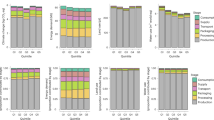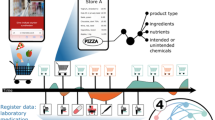Abstract
One of the potential exposure pathways of concern when assessing human exposures to environmental contaminants is the ingestion of contaminated foods. Individuals who live near contaminated sites and who grow their own food may be at a higher risk than the general population. Estimating exposures to this subpopulation requires an analysis of homegrown food intake rates. The Nationwide Food Consumption Survey (NFCS) 1987–1988 data were used to generate intake rates for home-produced foods. Results of the analysis show that, among the general population, homegrown vegetables (18%) were the most commonly consumed of the major food groups, followed by fruit (8%), meat (5%), fish (2%), and dairy products (0.8%). The intake rates for the major food groups vary according to region, age, urbanization, and race. In general, intake rates of home-produced foods are higher among populations in non-metropolitan and suburban areas and lowest in central city areas.
This is a preview of subscription content, access via your institution
Access options
Subscribe to this journal
Receive 6 print issues and online access
$259.00 per year
only $43.17 per issue
Buy this article
- Purchase on Springer Link
- Instant access to full article PDF
Prices may be subject to local taxes which are calculated during checkout
Similar content being viewed by others
References
Buck, R. J., Hammerstrom, K. A., and Ryan, P. B. Estimating long-term exposures from short-term measurements. J Expos Anal Environ Epidemiol. (1995) 5: 359–373.
Buck, R. J., Hammerstrom, K. A., and Ryan, P. B. Bias in population estimates of long-term exposures from short-term measurements of individual expsoure. Risk Anal. (1997) 17(4): 455–466.
Slob, W. Modeling long-term exposures of the whole population to chemicals in food. Risk Anal. (1993) 13(5): 525–530.
USDA. Food yields summarized by different stages of preparation. Agriculture Handbook No. 102. US Department of Agriculture, Agricultural Research Service, Washington, DC. 1975.
USDA. Data Set: Nationwide Food Consumption Survey 1987/88 Household Food Use. 1987/88 NFCS Database. NTIS Accession No. PB92-500016. US Department of Agriculture, Washington, DC. 1987–1988a.
USDA. Food Consumption Survey 1987/88. Individual Intake. 1987/88 NFCS Database. NTIS Accession No. PB90-504044. US Department of Agriculture, Washington, DC. 1987–1988b.
USDA. Changes in Food Consumption and Expenditures in American Households During the 1980s. Statistical Bulletin No. 849. US Department of Agriculture, Washington, DC. 1992.
USDA. Food and Nutrient Intakes by Individuals in the United States, 1 Day, 1987–88. Nationwide Food Consumption Survey 1987–88, NFCS Report No. 87-I-1. 1993.
USDA. Food Consumption and Dietary Levels of Households in the United States, 1987–88. Report No. 87-H-1. US Department of Agriculture, Agricultural Research Service. 1994.
US EPA. Risk Assessment Guidance for Superfund (RAGS): Volume I. Human Health Evaluation Manual, Part A. EPA/540/1-89/002. 1989.
US EPA. Record of Decision. ROD ID EPA/ROD/R10-91-029 http://www.epa.gov/oerrpage/superfund/sites/query/rods/r1091029.htm1991.
US EPA. Record of Decision. ROD ID EPA/ROD/R04-93-166 http://www.epa.gov/oerrpage/superfund/sites/query/rods/r0493166.htm1993.
US EPA. Validation Strategy for the Integrated Exposure Uptake Biokinetic Model for Lead in Children. EPA/540/R-94-039, NTIS No. PB94-963504. (1994.
US EPA. Soil Screening Fact Sheet Guidance. EPA/540/F-95/041. (1996.
US EPA. Exposure Factors Handbook. National Center for Environmental Assessment, Office of Research and DevelopmentEPA/600/P-95/002Fb 1997.
Acknowledgements
The US EPA funded this research under contract with Versar (contract no. 68-D3-0013). SAS programming was conducted by Dr. Jay Wind from Versar and QA/QC was conducted by Dr. Jonathan Becker. In addition, for the major food groups, distributions were generated for each region by season, urbanization, and responses to the questionnaire. Results of these analyses can be found in US EPA (1997). The views expressed in this paper are those of the authors and do not necessarily reflect the views or policies of the US Environmental Protection Agency.
Author information
Authors and Affiliations
Corresponding author
Rights and permissions
About this article
Cite this article
MOYA, J., PHILLIPS, L. Analysis of consumption of home-produced foods. J Expo Sci Environ Epidemiol 11, 398–406 (2001). https://doi.org/10.1038/sj.jea.7500181
Received:
Published:
Issue Date:
DOI: https://doi.org/10.1038/sj.jea.7500181
Keywords
This article is cited by
-
Estimation of age-specific per capita home-produced food intake among populations that garden, farm, or raise animals
Journal of Exposure Science & Environmental Epidemiology (2012)



